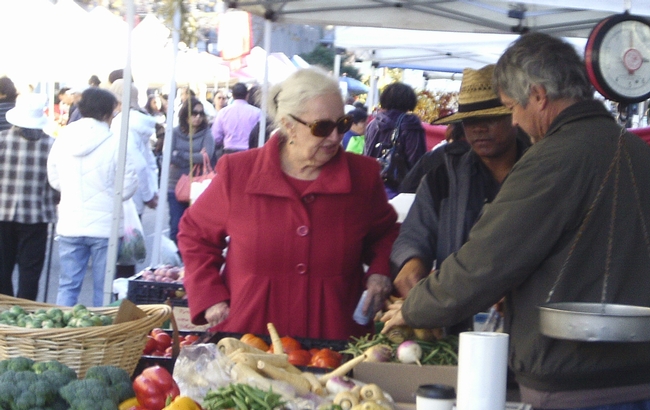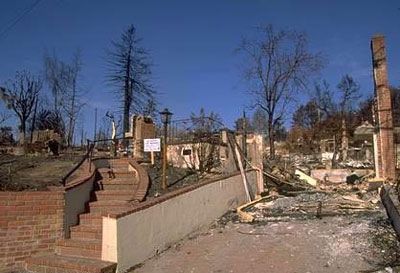
Posts Tagged: Oakland
Community Produce Stand opens March 2 in East Oakland

To improve access to fresh produce for low-income seniors who live in a food desert in East Oakland, UC ANR Cooperative Extension in Alameda County, in partnership with Oakland Housing Authority and Mandela Market Place, will be opening a Community Produce Stand.
The Community Produce Stand will be open on the first Wednesday of every month, from 2 p.m. to 4 p.m., at 6401 Fenham Street in Oakland.
The produce stand will be located in the gazebo at Palo Vista Gardens, a low-income senior housing complex, and available to neighboring residents as well as people in two other Oakland Housing Authority sites, reaching more than 950 Oakland Housing Authority residents.
At the grand opening from 2 p.m. to 4 p.m. on Wednesday, March 2, a health fair will feature UC CalFresh representatives sharing healthy eating tips and recipes. La Clínica Dental, City Slicker Farms, Fresh Approach, Alameda County Community Food Bank and California Telephone Access Program will also participate and share resources.
The Community Produce Stand will accept CalFresh Electronic Benefit Transfer cards, said Tuline Baykal, UC CalFresh supervisor with UC Agriculture and Natural Resources in Alameda County. “Being able to buy fresh, affordable produce with EBT is important,” Baykal said, “because seniors and other residents may be tempted to opt for less healthy options to stretch their food dollars.”
Food deserts lack vendors that carry fresh fruit, vegetables and other healthful whole foods, and are usually found in poor parts of town. The supermarket closest to Palo Vista Gardens is 1.5 miles away. Between the housing site and the nearest store are half a dozen fast food restaurants and three liquor stores. Six convenience stores are in the vicinity, but they stock mostly processed, sugary and fat-laden foods.
“Low-income seniors often experience multiple barriers to healthful foods,” said Jaime Manalang, resident services coordinator with Oakland Housing Authority. “The lack of grocery stores and farmers' markets within close proximity to home, limited transportation options and their own physical mobility restrictions limit seniors' access to food, especially fresh fruits and vegetables.”
Healthful nutrition is critical for reducing the risk of disease and managing chronic health conditions, and is an important factor to living independently.
Knowing About Knowland Park's Biodiversity
It's all about knowing the biodiversity in Knowland Park. And trying to save it from development. Scientists and citizen-scientists will gather Sunday, June 1 in the western highlands of the Oakland park to conduct a "bioblitz"--or a tally of the biodiversity of animals and plants living...

Eddie Dunbar, founder and president of the Insect Sciences Museum of California, photographs insects.

Entomologist Eddie Dunbar will lead an insect survey of Knowland Park.
Do You Know What Your Pension Fund is Doing in Africa?

Betting on World Agriculture: US Private Equity Managers Eye Agricultural Returns, a new report from the Oakland Institute (OI), focuses on the private investment vehicles that advertise and manage investment opportunities in farmlands and agriculture for investors including pension funds, university and foundation endowments, and high net worth individuals. Based on months of research, involving literature review, interviews with fund managers, and examination of public as well confidential internal documents, the report casts a light on this hidden trend by profiling private investment vehicles that are either based in the US or aggressively promoting farmland and agriculture in the US.
Via Oakland Institute and Anuradha Mittal, Executive Director of the Oakland Institute and Global Food Systems Forum panelist.
Oakland Hills fire prompted changes in building laws

Fighting the wildfire was hampered by steep and narrow roads, houses with wood-shingle roofs, a restricted water supply, and fire hydrants that were incompatible with neighboring cities’ trucks. The wildfire, which burned for almost 72 hours, took 25 lives, devastated over a thousand acres of land, and destroyed more than 3,500 homes.
Oakland now requires all new Oakland Hills houses to have fire-resistant roofs, which include slate, clay, concrete roof tile or steel shingles, according to the Builders Wildfire Mitigation Guide, published by the UC Division of Agriculture and Natural Resources.
“These materials are more accessible now than in 1991,” said Steve Quarles, a researcher at the Insurance Institute for Business and Home Safety, a Florida-based organization that conducts studies on natural disasters aimed to reduce human and financial loss. Quarles retired from UC Cooperative Extension Aug. 1 after serving for 26 years as a wood durability advisor. “Probably most of them were available at that time, but now they are less expensive and people can acquire more information about them.”
How to decipher nutrition labels
Claudia Mosby, The Redding Record-Searchlight
A heart-healthy, sugar-free or low-fat label on your favorite box of crackers at the store doesn't automatically mean it's a healthy food item. These eye-catching labels draw attention to what may be a healthier choice, but to accurately assess the item's nutritional value you need to read and understand its nutrition facts label.
According to Concepcion Mendoza, nutrition family and consumer science advisor at University of California Cooperative Extension in Shasta and Trinity counties, nutrition facts labels became mandatory in the early 1990s. These labels list the number of calories, fat grams and nutrients per serving for a food item, along with its percent of daily value recommendation.
